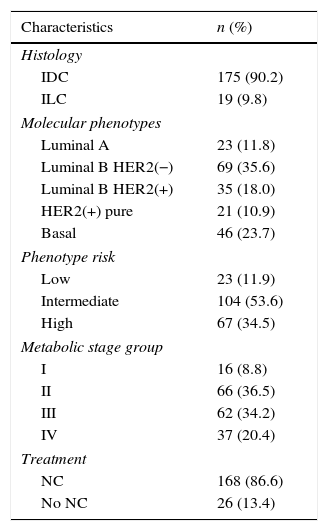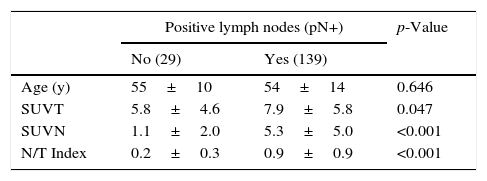To explore the relationship between basal 18F-FDG uptake in breast tumors and survival in patients with breast cancer (BC) using a molecular phenotype approach.
Material and MethodsThis prospective and multicentre study included 193 women diagnosed with BC. All patients underwent an 18F-FDG PET/CT prior to treatment. Maximum standardized uptake value (SUVmax) in tumor (T), lymph nodes (N), and the N/T index was obtained in all the cases. Metabolic stage was established.
As regards biological prognostic parameters, tumors were classified into molecular sub-types and risk categories. Overall survival (OS) and disease free survival (DFS) were obtained.
An analysis was performed on the relationship between semi-quantitative metabolic parameters with molecular phenotypes and risk categories. The effect of molecular sub-type and risk categories in prognosis was analyzed using Kaplan–Meier and univariate and multivariate tests.
ResultsStatistical differences were found in both SUVT and SUVN, according to the molecular sub-types and risk classifications, with higher semi-quantitative values in more biologically aggressive tumors. No statistical differences were observed with respect to the N/T index.
Kaplan–Meier analysis revealed that risk categories were significantly related to DFS and OS. In the multivariate analysis, metabolic stage and risk phenotype showed a significant association with DFS.
ConclusionHigh-risk phenotype category showed a worst prognosis with respect to the other categories with higher SUVmax in primary tumor and lymph nodes.
Analizar la relación entre la captación basal de 18F-FDG en tumores mamarios y la supervivencia en pacientes con cancer de mama (CM) bajo la aproximación del fenotipo molecular.
Material y métodosEste estudio prospectivo y multicentrico incluyó 193 mujeres diagnosticadas de CM. Todas las pacientes fueron sometidas a una 18F-FDG PET/TC previa al tratamiento. Se obtuvo el SUVmax en el tumor (T), ganglios linfáticos (N) así como el índice N/T en todos los casos. Además se determinó el estadio metabólico.
Atendiendo a los factores biológicos pronósticos, los tumores fueron clasificados en subtipos moleculares y categorias de riesgo. Se obtuvo tanto la supervivencia global (SG) como la supervivencia libre de enfermedad (SLE).
Se estudió la relación entre los parámetros metabólicos semicuantitativos con los fenotipos moleculares y las categorías de riesgo. Se analizó el efecto del subtipo molecular y las categorías de riesgo en el pronóstico mediante análisis de Kaplan–Meier y test uni y multivariantes.
ResultadosSe encontraron diferencias estadísticamente significativas en tanto el SUVT como el SUVN, deacuerdo a los fenotipos moleculares y las categorías de riesgo, con valores mayores en los tumores biológicamente más agresivos. No se observaron diferencias con respecto al índice N/T.
El análisis de Kaplan–Meier reveló que las categorías de riesgo se relacionaron de forma significativa con la SG y SLE. En el análisis multivariante, el estadio metabólico y la categoría de riesgo mostraron asociación significativa con la SLE.
ConclusionLa categoría de alto riesgo manifestó un peor pronóstico con respecto a las otras categorías, con mayores valores de SUVmax tanto en el tumor primario como en ganglios linfáticos.
Article
If you experience access problems, you can contact the SEMNIM Technical Secretariat by email at secretaria.tecnica@semnim.es or by phone at +34 619 594 780.

Revista Española de Medicina Nuclear e Imagen Molecular (English Edition)














